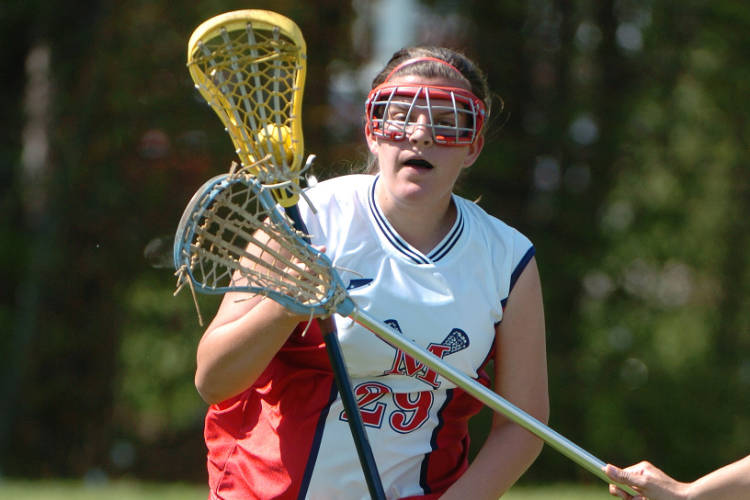Cradling is a vital part of lacrosse, especially for women. Because our pockets are more shallow than in the men’s game, we have to use our cradling skills to make sure that the ball stays in the crosse while we are on the run. It’s a skill that takes time and practice to develop. And if you aren’t careful, you can actually develop bad habits that make it hard to cradle well while you’re running. So, let me give you some tips on how to cradle in women’s lacrosse.
How cradling in lacrosse works
The centrifugal force from cradling keeps the ball in place while we jostle around on the field. It’s just like swinging a bucket full of water around. The faster you swing, the more stable the water is in your bucket.
Anytime you’re on the move, you should be cradling. Not only will it help shelter the ball, but it can also protect it while a defender attempts to check your lacrosse stick. Although it can be a little difficult to get the hang of, learning how to cradle in women’s lacrosse is one of the most important skills you can develop. Being good at cradling allows you to focus on things like looking for a pass or dodging around a defender instead of wondering whether or not the ball is in your stick.
Being really good at cradling also buys you time. If you’re not the fastest runner on the field, solid cradling is your best bet for keeping the ball away from the other team.
Arm and hand placement when cradling in lacrosse
When you’re getting the hang of how to cradle in women’s lacrosse, always remember that no matter which hand you favor, right or left, the goal is to be equally comfortable on either side. If you have a weak side, usually your non-dominant or off-hand, the other team will know it. And they WILL go after that weakness. So practice, practice, practice!
Bottom hand – Non-Dominant hand
Whether you’re right-handed or left-handed, your non-dominant hand will be at the butt-end of your stick, while your dominant hand will be somewhere in the middle. The bottom hand is to provide stability and help with larger movements while you are cradling, while your dominant hand provides the detailed movements.
Your non-dominant arm should be somewhat tucked close to your body with a slight 45-degree angle at the elbow. Then, picture the lower part of your arm swinging open and closed like a door. It should be moving 180 degrees, like tracing a half-circle. Start doing this with your stick in your hand, so your arm can get accustomed to the weight.
Hold your stick so that the open face is towards you. The back of the stick should face away. Keep “opening and closing the door” with your non-dominant hand to get used to the motion. When we cradle, we use the phrases “ear to ear” or “shoulder to shoulder.” You won’t have to move the stick around this much while running on the field, but to get the basic mechanics down, it’s better to start big and go smaller as you get more comfortable. As it gets easier, you might find that “ear to nose” is better for running.
Top hand – Dominant hand
While the bottom hand provides steadiness, the finesse comes from the top hand. The bottom hand should be making the large movements of the cradle, while the wrist action should be coming from the dominant hand. As it’s following the “open and closed” movement of the bottom hand, the top hand is turning the stick slightly so it traces the edge of that half-circle motion we were talking about earlier.
You want to use your wrist to turn your stick in a slightly round motion to keep that centrifugal force going; that’s what keeps the ball in the stick!
While your bottom arm is going to stay close to your body, the top, or dominant arm will be slightly higher and away from your body. You don’t want to keep it too far out, however, since that can lead to clumsy cradling. Keep your arm out just enough to comfortably make the back and forth motion. There should also be an angle in your dominant elbow, the angle should increase and decrease as you move it to and fro.
On the move cradling vs standing cradling
Like we mentioned above, while you are running, cradling with wide motions can be difficult. That’s why, when we are on the go, it’s easier to follow the “ear to nose” movement. Tracing a quarter of a circle instead of a half-circle is easier to control and easier to run with.
The same techniques still apply to this smaller range: keep your bottom hand steady for the basic movement, but control the turn with your dominant wrist. I found it great to cradle to the rhythm of my running, but that might simply be an automatic movement for everybody.
While you’re standing, whether it’s during a play or you are cornered by some defenders in the midfield, you don’t have to cradle non-stop. There’s no longer a threat of the ball falling out like when you are running. You simply have to be aware of protecting the ball from defenders. (Make sure to follow the shoulder, shoulder, ball rule: keep both shoulders in between the ball and your defender.) This is where I found myself subconsciously cradling from ear to ear instead of ear to nose.
Switching hands while cradling
As you get better over time, switching from your dominant to your non-dominant hand will be something you need to get comfortable doing. Being able to pass, catch, and cradle with both hands is a necessity! It will help you get out of a tight spot and escape defenders.
Switching while on the move is important, especially for the midfield. The main thing to keep in mind is that switching hands should be very fluid; it should be done in one quick movement. We switch hands usually because there is an immediate threat and we need to protect the ball, so the ball should end up by the opposite shoulder by the end of the movement.
As you bring your stick from one side to the other, you’ll take your bottom hand completely off the stick. You’ll need to bring it up to where your dominant hand is and place it just above. At that moment, it should look like both hands are right next to each other in the middle of the stick. As you plant your non-dominant hand on top, slide your dominant hand to the butt. Congratulations, you just switched your hands! The important thing is to switch your hands in one cradle motion.
How to cradle in women’s lacrosse wrap up
Cradling is incredibly important in lacrosse. There’s a lot of running, so there will be a lot of cradling as well. After all, once you’ve got the ball, you want to do everything you can to keep it. Lucky for you, cradling is something you can practice while you do anything, like watch TV. Once you get that ear to ear, or ear to nose, movement down, you’ll be unstoppable on the field!

